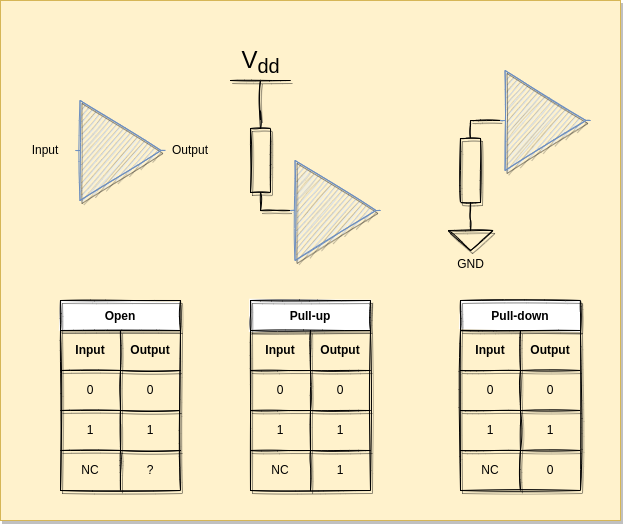02 - Repeat after me
Managing Inputs
We now want to talk to that FPGA. For that we have to declare an input:
LOCATE COMP "port_i" SITE "E1";
IOBUF PORT "port_i" PULLMODE=UP IO_TYPE=LVCMOS33;
Be really careful, the inputs on an FPGA are way more sensitive than on microcontrollers. Thankfully, really often you just burn that IO or a group of IOs so the FPGA still works but with less IOs.
Do not connect coils directly (relays, motors, speakers) and make sure you are using 3.3V logic (or lower if you defined lower in your LPF file) if you are connecting to something else.
The FPGA contains pull-ups and pull-downs that you can set at synthesis time:
For more details on how the ECP5 handles the IOs see: https://www.latticesemi.com/-/media/LatticeSemi/Documents/ApplicationNotes/EH/FPGA-TN-02032-1-3-ECP5-ECP5G-sysIO-Usage-Guide.ashx?document_id=50464
Memory
In Verilog, you can create data types of arbitrary types:
reg [SIZE-1:0] buffer;
This will create a register of SIZE bits called buffer.
To access a single bit, you use the bit index. Verilog uses zero-based indexing, so the least significant bit (LSB) is at index 0 and the most significant bit (MSB) is at index 7. For example, buffer[0] accesses the LSB of buffer, and buffer[SIZE-1] accesses the MSB.
To access a range of bits, you use a colon to specify the bit range. For example, buffer[3:0] accesses the least significant 4 bits of buffer, and buffer[7:4] accesses the most significant 4 bits (assuming SIZE=8 here).
We can set the value of a register at the beginning of the life of the module:
initial begin
buffer = 8'b01010101;
end
Code
follow.lpf:
LOCATE COMP "clk_i" SITE "P3";
IOBUF PORT "clk_i" IO_TYPE=LVCMOS33;
FREQUENCY PORT "clk_i" 25 MHZ;
LOCATE COMP "led_o" SITE "U16";
IOBUF PORT "led_o" IO_TYPE=LVCMOS25;
LOCATE COMP "port_i" SITE "E1";
IOBUF PORT "port_i" PULLMODE=UP IO_TYPE=LVCMOS33;
follow.v
module top(input clk_i, input port_i, output led_o);
reg led_reg;
wire baseclk;
clkdiv #(.DIV(200000)) slowclk (clk_i, baseclk);
ring_buffer buffer (baseclk, port_i, led_o);
endmodule
module ring_buffer (
input wire clk,
input wire data_in,
output wire data_out
);
reg [255:0] buffer;
reg [7:0] write_pointer;
reg [7:0] read_pointer;
initial begin
buffer = 256'b0000000000000000000000000000000000000000000011111111000000001111111100000000111111110000000011111111111111110000000011111111111111110000000011111111111111110000000011111111000000001111111100000000111111110000000000000000000000000000000000000000000000000000;
end
always @(posedge clk) begin
buffer[write_pointer] <= data_in;
write_pointer <= write_pointer + 1;
read_pointer <= read_pointer + 1;
end
assign data_out = buffer[read_pointer];
endmodule
module clkdiv #(parameter DIV = 24'd5000)(
input wire clk_i,
output wire clk_o
);
reg [24:0] count = 25'b0;
reg clk_o_internal = 1;
//on this board we have a 25MHz clock
always @(posedge clk_i) begin
count <= count + 25'b1;
if(count == DIV) begin
count <= 25'b0;
clk_o_internal <= ~clk_o_internal;
end
end
assign clk_o = clk_o_internal;
endmodule
Build
yosys -p "synth_ecp5 -top top -json follow.json" follow.v
nextpnr-ecp5 --json follow.json --textcfg follow.config --25k --package CABGA381 --lpf follow.lpf
ecppack --compress --svf follow.svf follow.config follow.bit
Upload
ecpdap program follow.bit
sudo $HOME/oss-cad-suite/libexec/openFPGALoader -b "colorlight-i5" --freq "16000000" follow.svf
Exercice
- Make it have a longer memory, bonus points if it is a parameter to the module
